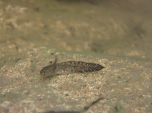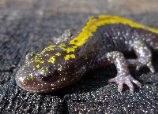Southern Long-Toed Salamander (A. m. sigillatum)
Description: Adults are 1 3/5 to 3 1/2 inches long from snout to vent, 4 to 6 2/3 inches in total length. A medium-sized salamander. The body is stout with 12 to 13 costal grooves and a broad rounded head, a blunt snout, small protuberant eyes, and no nasolabial grooves. The tail is flattened from side to side to facilitate swimming. Large untransformed aquatic adults have gills on either side of the head. Dusky or black above with a yellow dorsal stripe, usually interrupted by dark blotches. The sides are sprinkled with whitish specks. The venter is grey or black. Larvae have broad heads, three pairs of bushy gills and broad caudal fins that extend well onto the back.
Habitat: Inhabits alpine meadows, high mountain ponds and lakes.
Range: In California this subspecies occurs in the Northeast and along the northern Sierra Nevada south to Garner Meadows and Spicer Reservoir, and in Trinity and Siskiyou Counties near the Trinity Alps. It also occurs in southwestern Oregon.
Found in these States:
CA |
OR
Diet: Carnivorous. Transformed adults eat small invertebrates, including worms, mollusks, insects, and spiders. Larvae start by eating small crustaceans. As they increase in size, they gradually consume larger prey items, including crustaceans, worms, mollusks, and frog tadoles. Larger larvae may cannibalize smaller larvae. Young larvae feed by sitting and waiting for prey, while larger larvae also stalk and pursue prey.
Reproduction: Reproduction is aquatic. Breeding occurs in permanent or temporary ponds, lakes and flooded meadows. Adults become sexually mature at 1 to 3 years, and migrate overland from wintering sites to the breeding site in spring and early summer or later in years with a heavy snowpack. Adults sometimes enter ponds not yet free of ice. (In Oregon, Long-toed Salamanders may migrate to ponds in October and November.
Males enter the ponds before females.Females spend approximately 3 weeks at a breeding site, but individual females only stay at the site for 1 to 2 days, and do not feed there.Males feed at breeding sites, so they can stay at the site for the entire breeding season, which may last 2 months or more.
Status: Listed as Least Concern in view of the large extent of occurrence, large number of subpopulations, presumed large population size, and use of a wide range of habitats.
»» Kingdom: Animalia - Animals
»» Phylum: Chordata - Chordates
»» Subphylum: Vertebrata - Vertebrates
»» Class: Amphibia - (Amphibians)
»» Order: Caudata - Salamanders
»» Family: Salamandridae - Newts
»» Subfamily: Pleurodelinae - Pleurodeline Newts
»» Genus: Ambystoma
»» Species: Ambystoma macrodactylum - Long-Toed Salamanders
»» Subspecies: A. m. sigillatum - Southern Long-Toed Salamander
This article uses material from the Wikipedia article "Long-Toed Salamander", which is released under the Creative Commons Attribution-Share-Alike License 3.0. Content may have been omitted from the original, but no content has been changed or extended.
|













